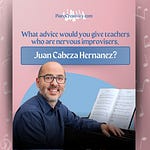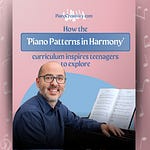Here’s the second in a series of clips from an interview with Professor Karen Schlimp, an improvisation professor from Austria and author of a couple of wonderful books on teaching creativity.
It will appeal particularly to those of you who struggle with the relatively common problem of students who get nervous when improvising.
(There’s a transcript at the bottom of this post.)
She makes two big points in the video:
“Play freely” is a better instruction than “improvise”
The most effective learning takes place when the student is at the border between feeling challenged and feeling comfortable, so be careful to restrict how much freedom the student has.
In my experience it is best to relate any improvisations directly to the repertoire/theory/technique that the student is studying in the rest of the lesson. This has three benefits:
It deepens your students knowledge of the lesson topic
It gives them the opportunity to be creative
It strengthens their performance resilience — as this fascinating post from Dr. Noa Kageyama illustrates.
Karen Schlimp is a Professor at the Anton Bruckner Privat University in Linz, and a Lecturer for Ensembles and Improvisation at the Music University in Salzburg and Vienna. She is also the author, with Peter Jarchow, of Impromosaik: das verrückte Klappbuch mit unbegrentzen Ideen zum Improvisieren (“the crazy folding book with unlimited ideas for improvisation”), published by Breitkopf & Härtel, and Klangwege: Improvisation anregen — lernen — unterrichten, (“Soundpaths: stimulating improvisation — learning — teaching”) published by Lit Verlag.
Transcript:
Garreth: When my students are nervous about improvising, I talk to them and I say, I'm improvising what I'm saying to you now. I haven't got it written down in my head, I'm just making it up. And that's what conversation is. Improvisation is conversation.
Karen: Yeah, for me too. Because when children learn to speak, they just try out and readily, they can speak and afterwards they go to school and learn writing and reading. And in Western music, it's most of the time the other way around. It makes me a little bit sad because it could be integrated all together. If people are scared about improvisation, I don't use the word improvisation. I just say ‘play free’.
Garreth: Yeah, me too. I find that's really, liberating actually, isn't it? Because the word ‘improvisation’ makes people feel nervous. That's actually something some of my readers have asked about; how do you get your students to feel relaxed when they're improvising? And obviously ‘play free’ is part of that, but do you have any other tips for them?
Karen: You have to have something to hold onto so that you feel comfortable. And there must be some challenge where you be free. Learning usually is at the border between where you are challenged and you feel comfortable. So if a student is not very familiar with improvisation, I give them a good material that they know what to play, and then I give some freedom.














Share this post